Yemen exhibits its ancient heritage in various locations across its land, some of which have been designated as World Heritage Sites such as Old Sanaa City, the Historic Town of Zabid, the Old Walled City of Shibam, and the Socotra Archipelago. Yemen's heritage extends to Old Saada City as well, Belqis' Throne, the Maarib Dam, Awaal Sirwah, Baraqish, Kawkaban and other magnificent sites. Below is a slide show exhibiting pictures of Yemen's heritage. Further down below is a complaint to the UN Special Rapporteur in the field of cultural rights detailing the destruction caused to Yemen's heritage by Saudi-led Coalition airstrikes and shelling.

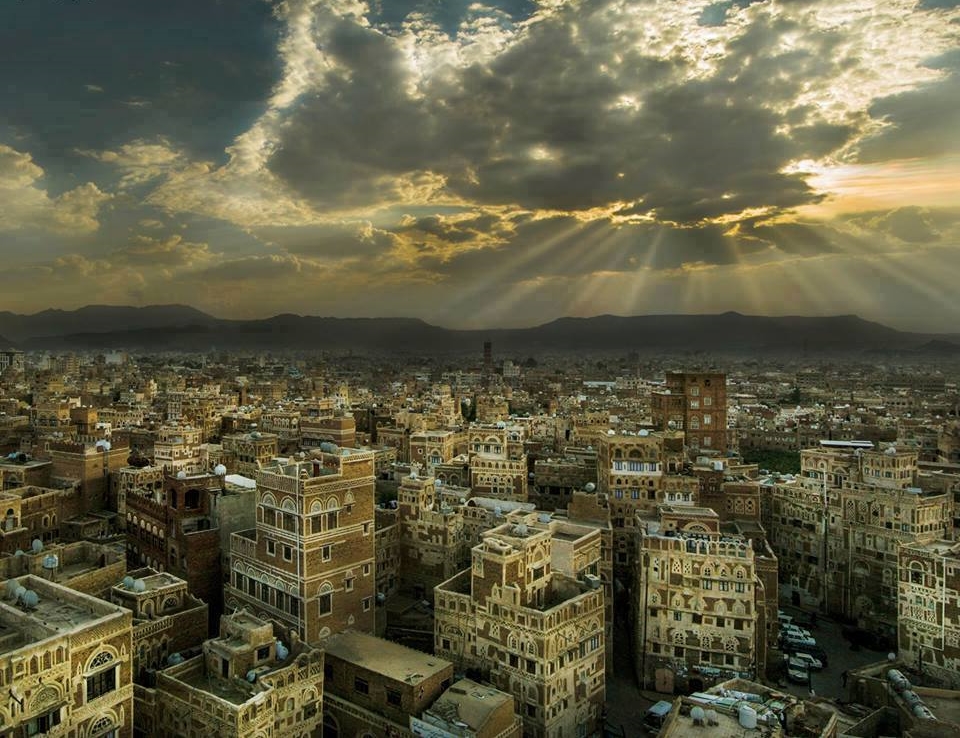
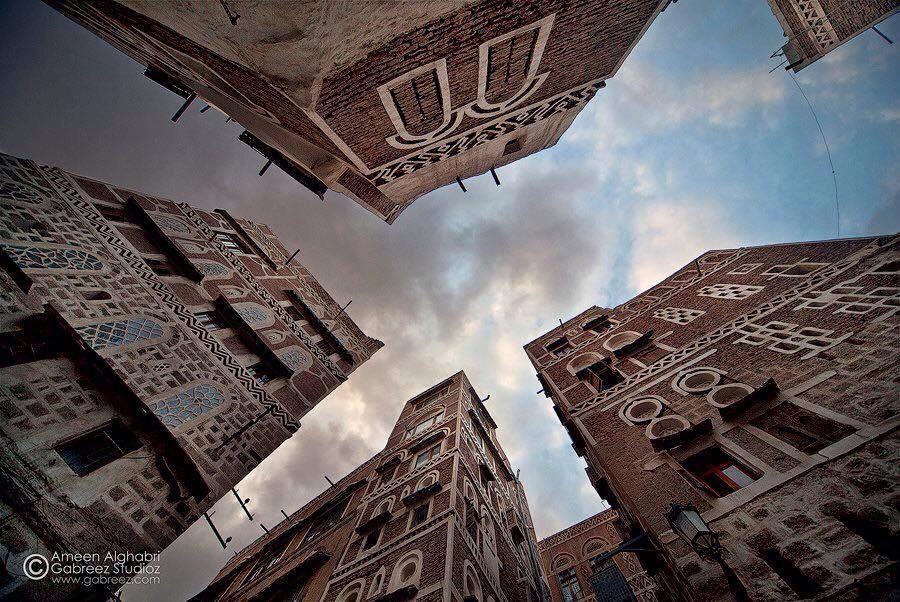


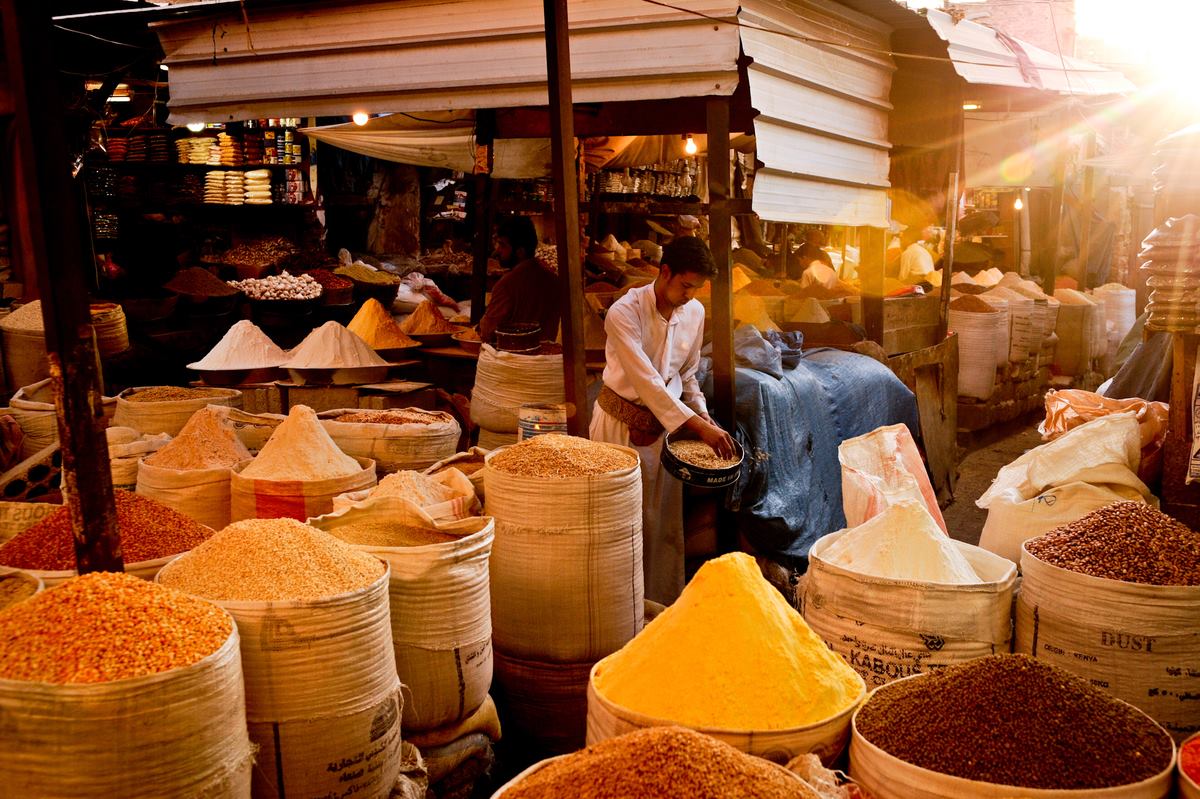
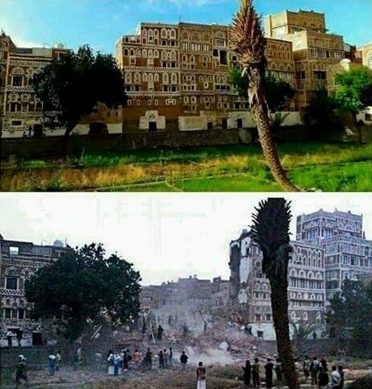
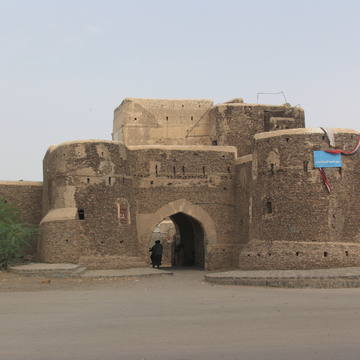

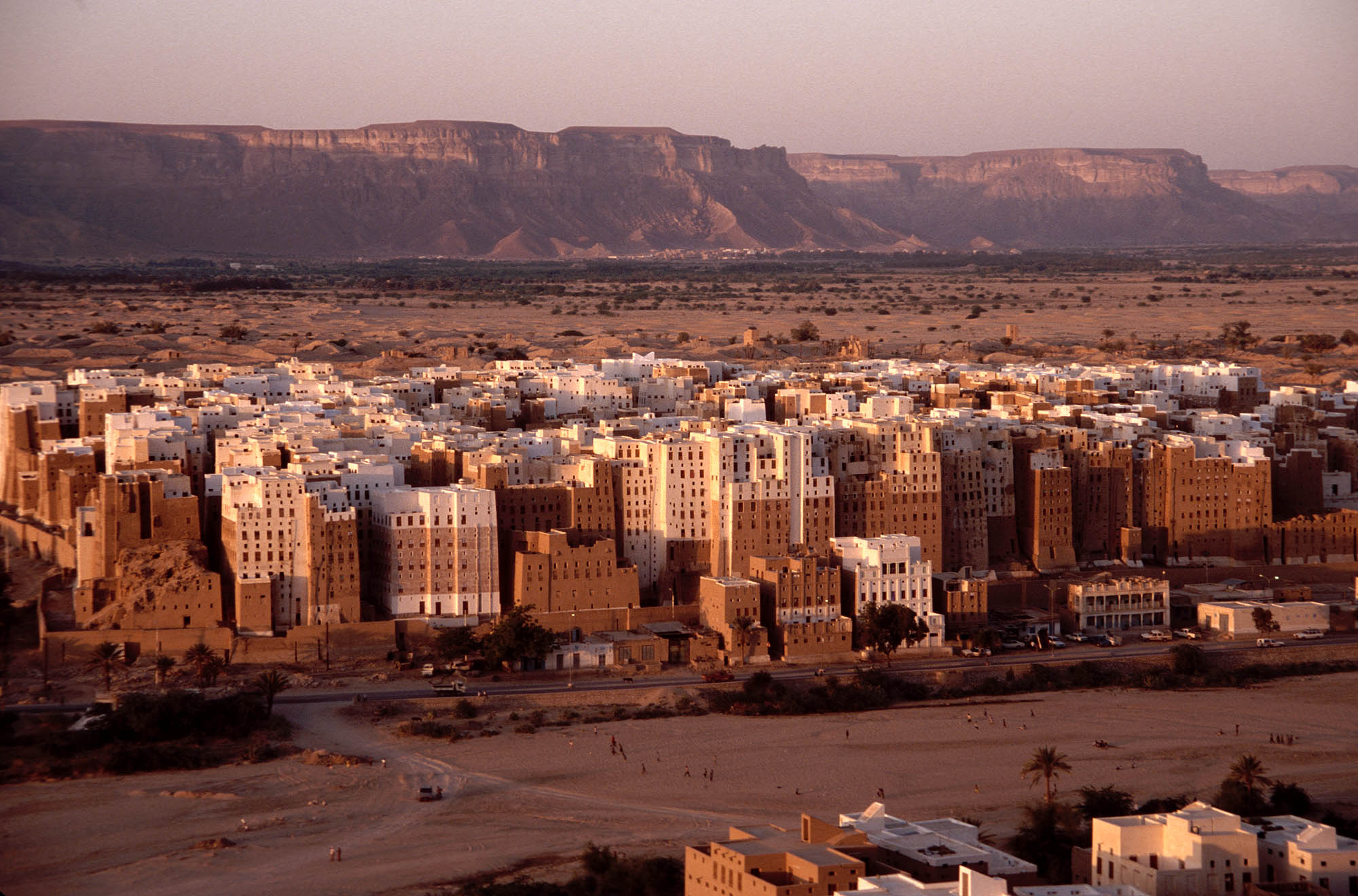

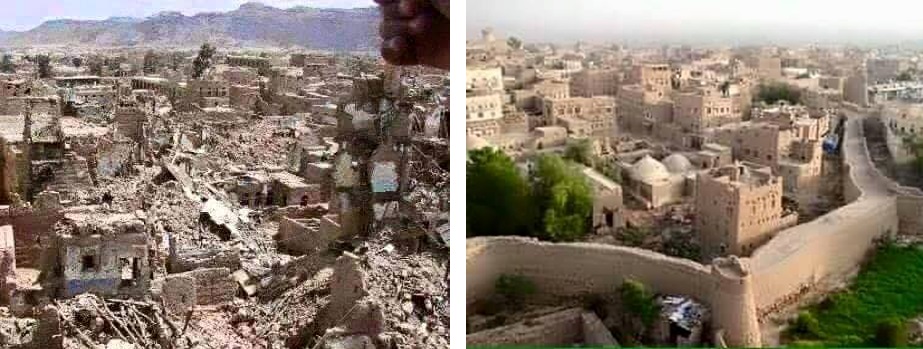



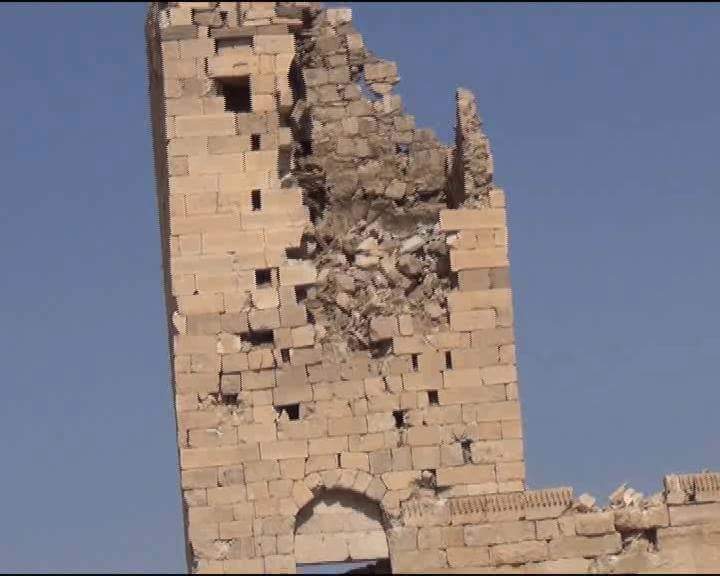
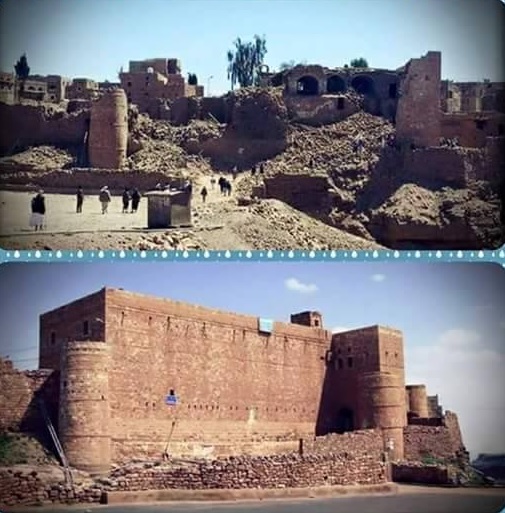
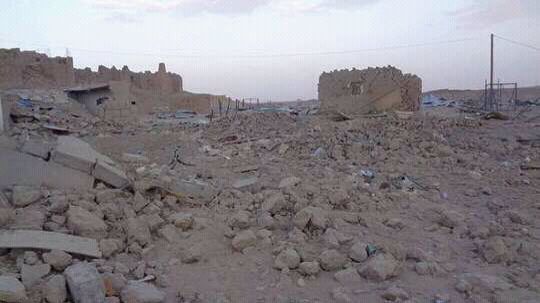

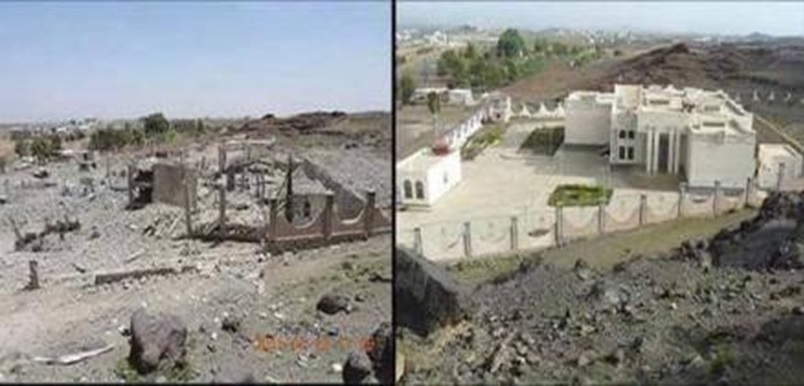
Intentional and Systematic Destruction of Yemen’s Heritage by the Saudi-led Coalition
Historical Background
1. On 26 March 2015, a coalition led by Saudi Arabia consisting of the United Arab Emirates, Qatar, Kuwait, Bahrain, Egypt, Jordan, Morocco, and Turkey (together “the Saudi-led coalition”) launched a war on the people of Yemen without a UN mandate. From the outset, this Saudi-led coalition was supported politically, diplomatically, and militarily by the United States of America, the United Kingdom and France. After months of stalemate the number of countries participating in the Saudi-led coalition increased to include Sudan and Senegal, both sending large numbers of troops to Yemen. In addition to hiring Sudanese and Senegalese troops, the Saudi-led coalition relied and continues to rely heavily on the use of mercenaries.
2. The coalition employed and continues to employ airstrikes and the imposition of a comprehensive land, air, and sea blockade that fails to have legally justifiable grounds, and in its conduct fails to abide by the principles of distinction, proportionality and military necessity in violation of the laws of war. To date, coalition airstrikes killed over 9,000 civilians and maimed over 20,000 others, over 1/3 of whom were women and children. The coalition has destroyed hundreds of thousands of residential homes along with more than 200 hospitals and clinics, over 500 schools, 39 universities and vocational institutes.
3. The coalition has additionally destroyed several sites designated as World heritage by UNESCO. A number of heritage sites in Yemen have been intentionally targeted by Saudi-led coalition airstrikes without justification. These heritage sites are not military objectives, as they are of no military value given their exposed location on flat empty lands. The targeting of the heritage sites is not justified by military necessity. According to ARWA sources on the ground, these sites were never afforded military protection nor were they used for military operations. In addition, the Saudi-led coalition has never made a claim justifying the destruction of the sites because of military necessity. The airstrikes have totally destroyed or partially damaged over 27 heritage sites in Yemen, including those designated by UNESCO as World Heritage Sites.
Statement of Facts and Allegations
4. Old Sanaa City is an ancient fortified city that has been continuously inhabited for more than 2,500 years and contains many intact architectural gems. In 1986, it was declared a World Heritage Site by UNESCO, and many efforts have been made to preserve some of the oldest buildings and markets. Some of the city’s structures are more than 1400 years old, such as the Aljami3 Alkabeer (Grand Mosque of Sana'a) and Souk Elmilh (central market). Surrounded by ancient clay walls which stand 9–14 meters high, the old city contains more than 100 masjids, 14 hammams (bathhouses), water wells both inside and outside homes, and about 6,500 residential homes. Many of the homes are considered ancient skyscrapers, being 5 to 7 stories high, and make for narrow alleys and pathways. They are decorated with elaborate horizontal hand-plastered friezes and intricately carved stained-glass windows. Prior to the invasion, one could experience Old Sanaa as not only a World Heritage Site, but as a vibrant living community of Yemenis. Since the beginning of the conflict in Yemen, several houses within the World Heritage city of Old Sana’a suffered damage and collapse as a consequence of repeated Saudi-led coalition airstrikes.
- On 11 May 2015, a coalition airstrike on a weapons depot on Mt. Niqm caused a massive explosion destroying the nearby area. It also caused the ignition of tens of Katyusha rockets that flew in every direction, some causing damage to the buildings in Old Sanaa City approximately 5 kilometers away from the Niqm depot.[2]
- On 9 June 2015, the Ottoman era Al-Owrdhi historical compound, located just outside the walls of the Old Sanaa City, was also severely damaged by a coalition airstrike.[3]
- On 12 June 2015, coalition airstrikes targeted four homes in the city, reducing them to rubble and killing at least 5 members of the Abdelqader family, who were inside sleeping at the time. The deceased include Hassan Yahya Abdelqader, his wife Amat Almalik, his brother Rashad, and son Abdullah and his cousin Shawqi. Other buildings destroyed include the magnificent complex of traditional houses in the Al-Qasimi neighborhood, bordering an urban garden called Miqshama, near the Sailah water channel.[4]
- On 17 September 2015, at 11:30 P.M., the coalition targeted with a missile airstrike a known urban garden named Almiqshama in the historic Old Sanaa City belonging to Hifdhullah Alaini. The airstrike caused Hifdhullah Alaini’s death and the death of his 11 family members. The coalition airstrike injured an additional five civilians. In addition to the loss of life, the airstrike also caused the complete destruction of Alaini’s home, as well as the destruction of several neighboring houses. No apparent legitimate military target was in the vicinity.[5]
5. The historic town of Zabid's domestic and military architecture and its urban plan make it an outstanding archaeological and historical site. The town is known for its architecture, including its walls, watchtowers and citadel, schools, a central masjid and 80 surrounding masjids, and a network of narrow alleys walled by homes built from burnt bricks. Besides being the capital of Yemen from the 13th to the 15th century, the city played an important role in the Arab and Muslim world for many centuries because of its Islamic university, Jamiat Alasha’er. It was proclaimed a World Heritage Site by UNESCO in 1993.
- On 12 May 2015, Saudi-led coalition airstrikes targeted a market area of the historic town of Zabid, killing at least 60 people and wounding more than 20 others. The airstrike caused extensive damage to the surrounding area.[6]
6. Old Saada City is one of the oldest medieval cities in Yemen, important for its historical, architectural, urban and spiritual achievements. Although not a World Heritage Site it is being reviewed currently and may be designated a World Heritage Site sometime in the future. Founded in the 9th century AD by Imam AlHadi bin Imam Yahya bin Imam Alhussein bin Imam Ali, Saada is the birthplace of the Zaydi Islamic school of thought. Saada has thrived throughout the centuries, continuously inhabited in a medieval manner with earthen architecture, very characteristic and representative of the entire region.
- From 6 April 2015 to 11 May 2015, repeated coalition airstrikes on Old Saada City destroyed a large part of its ancient civilian infrastructure. On 8 May 2015, the official spokesman of the coalition, Brigadier General Ahmed Alassiri, announced that the entire city of Saada was a military target, in violation of civilian protection principles enshrined in the Geneva Conventions. The airstrikes targeted and struck at least six residential houses not being used for military purposes. One attack killed 27 members of a single family, including 17 children. The airstrikes also hit at least five markets for which there was no evidence of military activity. Aerial attacks on an empty school and a crowded petrol station also appear to have violated the laws of war. [7]
- On 9 May 2015, Masjid Imam Alhadi was targeted by coalition airstrikes that severely damaged a third of the Masjid’s property. This masjid was established in Saada in 897 AD, more than 1100 years ago.[8]
7. Sheba was the South Arabian Kingdom of Saba, centered around the oasis of Maarib in present-day Yemen. The people of the Kingdom were called Sabaeans and existed around the first millennium B.C. Early South Arabian trade with Mesopotamia involving wood and spices transported by camels is attested to in the early 9th century B.C. and may have begun as early as the 10th Century BC.
- On 19 January 2016, the historical monuments in Sirwah were severely damaged by Saudi-led coalition airstrikes and shelling. Some of the large stones that were damaged have writings dating back to the 1st Millennium B.C. – providing information that helps us understand events and methods of living from over 3000 years ago. Eyewitnesses have said that some of the damage was caused by constant shelling in the Sirwah area by Saudi forces in addition to coalition airstrikes. The area has no military presence given the flat lands and their exposure.[9]
- On 31 May 2015, coalition airstrikes targeted and destroyed parts of the Maarib Dam.[10] With an expanse of 98 hectares, the Sabaean capital Maarib was the largest ancient city in South Arabia and is considered one of the most significant historic sites on the Arabian Peninsula. Despite climatically unfavorable conditions, at the end of the 1st Millennium B.C., a complex society emerged in Maarib, whose economy relied on a highly developed irrigation system made possible by the Maarib Dam, itself considered a wonder of technical engineering. Due to its economic prosperity and geographic location, Maarib became the most important trading station along the Incense Route. From the capital Maarib, the Sabaeans controlled extensive parts of the country as well as the trade on the incense route as far as the Mediterranean and Mesopotamian areas.
8. Baraqish has been inhabited from time immemorial. Dating back to the 1st Millennium B.C., the ancient city was known to the Greeks and Romans as Athlula from the ancient Sabaean Yṯl (or Yathill as it is commonly called today). Baraqish is surrounded by a wall 14 meters high, much of which is still visible today. Inscriptions mention that the wall was rebuilt by the Sabaeans in 450 B.C. Its origins date back to 1000 B.C., but it reached its peak of importance around 400 B.C. when it became the capital of the Minean Kingdom and later became known as a religious center housing the Temple of Nikrah. In the main area of the site, there still remain, the ruins of a dome, a well and tower.
- On July 1st, 2015, coalition airstrikes targeted the historical city of Baraqish which is located in what today is called Majzar district of the Maarib province. The airstrikes caused damage and destruction to the walls of the ancient city.[11]
9. Kawkaban is a town in the northwestern part of Yemen, containing a fortified citadel about 2800m above sea level. The town is perched on a hilltop, walled from the north and fortified naturally from the other directions. It was a capital of Bani Sharafaldeen in the 15th century. It was also home to a Jewish community. The city features several old masjids, the most prominent of which are Almadrasa, Almansoor, Alsharefa, and Harabat. The old market is located in the middle of the city. Old rainwater reservoirs can also be seen in the fortified town, named Meseda, Alasdad, and Sedalhamam.
- On 15 February 2016, a series of coalition airstrikes targeted and destroyed large parts of the historic town of Kawkaban, resulting in at least seven civilian deaths, including an elderly man, a woman, and a child; 29 civilian injuries including 8 women and 16 children; complete destruction of Alqishla fort and six residential homes; partial destruction of 12 residential homes; and damage to 70 others.[12]
10. The Alqahira Citadel stands 1500 meters above sea level at the peak of a mountain that overlooks Taiz city. According to historical sources, it was built before the arrival of the Prophet Mohammad. The Alqahira Citadel played important military and political roles throughout the long history of the Taiz region. It is also a rare architectural masterpiece, with different facilities that were restored, developed and maintained. Visitors in large numbers would visit its parks, restaurants, waterfalls, library, theater, museum, wings and extensions.[13] Saudi-led warplanes destroyed the citadel on 21 May 2015.
11. The Dhamar Regional Museum was the main museum of the Dhamar governorate. It was built at Hirran, north of Dhamar city, in 2002. It had several exhibition halls, a lecture hall, a computer laboratory, and storage rooms. Its pre-622 AD collection comprised over 100 inscriptions of various provenance and periods. The section dedicated to the Islamic archaeology contained some decorated artifacts bearing Arabic inscriptions, in addition to jewels and other handmade products of traditional handicrafts in Dhamar. The most important object was the wooden minbar (pulpit) from the Great Masjid of Dhamar city, dating back to the 10th Century A.D. The Dhamar Regional Museum was not a military objective nor was it being used for military operations. Coalition warplanes struck it with a missile on 21 May 2015, completely obliterating the structure and its contents.[14]
12. The National Museum was established in Sanaa in 1971 and houses 30,000 historical and cultural artifacts, including artifacts formerly in the possession of Yemeni Imam Yahya Hamidaddin; artifacts from Maarib, an ancient kingdom of Yemen; and artifacts from the post-622 A.D. era. On 11 May 2015, a Saudi-led airstrike struck and partially damaged the building.
13. Almawrooth Museum was established in Sanaa in 2004 and houses artifacts from different eras. On 11 May 2015, a Saudi-led airstrike struck and partially damaged the building.
14. Ataq Museum in Shabwa houses important relics from the ancient city of Shabwa, the capital of the ancient kingdom of Hadhramaut, as well as items unearthed from the archaeological sites of the ancient Qataban and Osan kingdom. On 22 June 2015, a coalition airstrike struck and partially damaged the building.
15. Alabdali Palace is a historical palace encompassing several buildings, the most prominent of which is the Aden Museum. On 22 June 2015, a coalition airstrike struck and partially damaged the building.
Legal Analysis
16. Under Article 3 of the 1954 Hague Convention for the Protection of Cultural Property in the Event of Armed Conflict (1954 Hague Convention), State Parties must act to safeguard their own cultural property against armed attack. For example, states have the responsibility to move such property away from potential or actual military action, or in the case of historical sites, states must avoid placing military objectives near to them. Except for the artifacts located in the museums which are buildings that are afforded protections under the Convention, the cultural property of the Yemeni people is mostly immovable heritage sites as evident by the list above. There has not been any substantiated evidence of placing military objectives in or around the heritage sites to the best of our knowledge, research, and analysis.
17. Article 4(1) of the 1954 Hague Convention, states that parties to the Convention must refrain “from any act of hostility, directed against such property.” As demonstrated above, the Saudi-led coalition targeted many heritage sites in a systematic repeated manner in violation of the 1954 Hague Convention. The wide net cast on all heritage sites indicates an intent to damage the culture of the people of Yemen by destroying and damaging multiple heritage sites, some of which constituyte World Heritage Sites that belong to all peoples.
18. Because cultural property is normally civilian in nature, the general provisions of humanitarian law protecting civilian property apply during times of war. Rule 38 of customary international humanitarian law enshrines the general principle that warring parties must respect cultural property. According to the rule, a) special care must be taken in military operations to avoid damage to buildings dedicated to religion, art, science, education or charitable purposes and historic monuments unless they are military objectives and b) property of great importance to the cultural heritage of every people must not be the object of attack unless imperatively required by military necessity. None of the aforementioned cultural heritage sites were used by the Yemeni military or Popular Committees in order to justify the designation of the sites as military objectives. Many of the aforementioned heritage sites are located on flat lands that are exposed and hence have no military value.
19. The only time an advance warning was given was when Old Saada City became a military target. Designating an entire city of 50,000 people as a military target not only violates the humanitarian law prohibition against placing civilians at risk, but also the prohibition against making threats of violence whose purpose is to instill terror in a civilian population. Given the systematic, widespread targeting of heritage sites all across Yemen, the Saudi-led coalition has violated international humanitarian law in a manner that flies in the face of the protections the law affords to people and their cultural property.
______________________________
Citations
[1] The entire complaint has been corroborated with Mohannad Alsayani, Head of The General Authority for Antiquities and Museums in Yemen, in addition to ARWA contacts on the ground.
[2] https://www.youtube.com/watch?v=SlGc_UkPXVw ; ARWA contact with an eye witness stating that while he was at his uncle’s house in Tabari he saw and heard two katyusha rockets whizzing by in different directions and later found out that some had reached Bayt Alkutf - Bab Alsabah and different parts of Old Sanaa approximately 5km away from the weapons depot.
[3] The Director General of UNESCO condemns the destruction of historic buildings in the Old City of Sana’a, Yemen, UNESCO, 12 June 2015. http://whc.unesco.org/en/news/1295/
[4] Euronews, 12 June 2015. https://www.youtube.com/watch?v=BxQlhHLJEFA
[5] Yemen Center for Human Rights.
[6] 2015-11-yemen-mena-zabid, Human Rights Watch, 19 November 2015. https://www.hrw.org/uk/node/283631
[7] Targeting Saada: Unlawful coalition Airstrikes on Saada City in Yemen, Human Rights Watch, 30 June 2015. https://www.hrw.org/report/2015/06/30/targeting-saada/unlawful-coalition-airstrikes-saada-city-yemen
[8] Almasira, 9 May 2015. https://www.youtube.com/watch?v=qajNo0srLXo
[9] Kristin Romey, ‘Engineering Marvel’ of Queen of Sheba’s City Damaged in Airstrike, The National Geographic, 3 June 2015. http://news.nationalgeographic.com/2015/06/150603-Yemen-ancient-Sheba-dam-heritage-destruction-Middle-East-archaeology
[10] See Endnote 9
[11] Iona Craig, The Agony of Saada: US and Saudi Bombs Target Yemen’s Ancient Heritage, 16 November 2015. The Intercept, https://theintercept.com/2015/11/16/u-s-and-saudi-bombs-target-yemens-ancient-heritage/
[12] Legal Center for Rights and Development
[13] Lizzie Porter, Yemen: the Unesco heritage slowly being destroyed, The Telegraph, 16 June 2015. http://www.telegraph.co.uk/travel/destinations/middle-east/yemen/articles/Yemen-the-Unesco-heritage-slowly-being-destroyed/
[14] See Endnote 9





